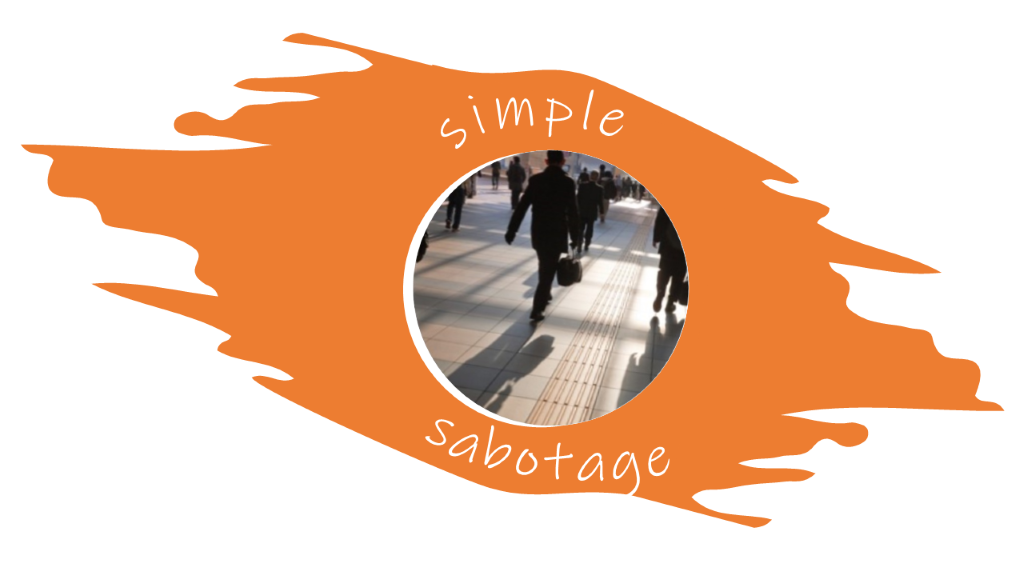
Simple Sabotage by Employees
Employees are a company’s most valuable asset. We talk a lot about how vital employees are to a company’s success and ways to invest in employees – and that’s a good thing. In this Simple Sabotage Series, we are taking a different approach and flipping the script to talk about ways organizations can be sabotaged by employees.
Considering that companies invest heavily in employees through compensation, training & development, and building company culture, when employees sabotage the workplace, it impacts the bottom line. Simple, persistent behaviors and habits can sabotage progress when organizations are unaware of the problems that exist in the first place. We believe if you first know your nemesis, you can combat it with the proper tools.
Our inspiration comes from the Simple Sabotage Field Manual. Originally published by the United States Office of Strategic Services (now the Central Intelligence Agency) in 1944, this manual was used by agents in motivating or recruiting potential foreign saboteurs. The now declassified booklet provides instructions for undermining progress and productivity by non-violent and unnoticed means. A section of the booklet tells how employees can sabotage their company.
The main ways listed are:
- Time
- Incompetency
- Stirring up strife
Any of these items look strangely familiar to you? Simple sabotage could be happening without intentional ill-will. It might just be happening due to people in your organization lacking self-awareness along with not being aware of others. It could be happening due to unhealthy habits that have gone unchecked for a long time. Maybe it is disgruntled employees who are actively trying to sabotage the company. It could be all of these things. Regardless, they are all leadership issues that must be resolved.
Let’s get further insights from the Field Manual of how simple sabotage can look under each of the bullets listed above.
Before we go there though, it is important for us to note that some of the strategies listed below are not detrimental if they are used in the proper way. For instance, some companies provide their employees with sick time when their employees are sick. That is great when used properly. Another example, sometimes employees’ working conditions need improvement and for an employee to voice that is justified. Keeping in mind that employees deal with a wide range of issues and they should be trusted when they voice concerns or are sick, we are talking specifically about employees who sabotage the companies they work for – knowingly or unknowingly. We realize not all employees do this.
Time
Employees are compensated for their time and work it takes to get their jobs done. Whether an employee is paid hourly or salary, time spent on the job can be wasted in many ways. Employees may also take “fake” sick leave, wasting the company’s benefits. The Field Manual lists these time-related simple sabotage strategies for employees:
- Work slowly. Think out ways to increase the number of movements necessary on your job.
- Contrive as many interruptions to your work as you can…take needless time to get the job done.
- Spend a long time in the lavatory.
- Forget tools so you have to go back after them.
Do these resonate with you? Bring to mind other ways you have seen time wasted?
Incompetency
Have you ever had an employee who barely squeezed by an acceptable mark on their performance review? How about the employee who works their way to a write-up then straightens up for a time only to lapse back into deficient performance? Most likely these employees are displaying incompetence in some or many areas of their work.
Here are specific strategies the Field Manual suggests:
- Pretend that instructions are hard to understand and ask to have them repeated more than once. Or pretend that you are particularly anxious to do your work and pester the foreman with unnecessary questions.
- Do your work poorly and blame it on bad tools, machinery, or equipment. Complain that these things are preventing you from doing your job right.
- Never pass on your skill and experience to a new or less skillful worker.
Have you seen any of these behaviors at your workplace?
Stirring up Strife
You may have had the unfortunate experience with an employee who is unhappy and they wanted to make sure everyone around was unhappy as well. If you have been there, you know it’s difficult to manage. Sometimes an employee’s complaint is valid. Other times the complaint can be bogus and interrupt progress, cause strife among the team, and ultimately impact company revenue.
Here are specific strategies the Field Manual suggests:
- Snarl up administration in every possible way. Fill out forms illegibly so that they will have to be done over; make mistakes or omit requested information in forms.
- If possible, join or help organize a group for presenting employee problems to the management. See that the procedures adopted are as inconvenient as possible for the management, involving the presence of a large number of employees at each presentation, entailing more than one meeting for each grievance, bringing up problems which are largely imaginary, and so on.
Have you seen any of these strategies in play? The good news is that CLG can help!
CLG helps companies get clear about their vision, mission, goals, strategy, structure, and people. We help organizations see things that may be sabotaging progress. Contact us today to address simple sabotage in your company and get on the road to success. Follow this content throughout the month of November as we continue to talk about employee sabotage.
Do you like the Simple Sabotage concept? Check out our Simple Sabotage Series here and stay tuned for next month’s blog and social posts as we wrap up the series by talking about lowering morale and creating confusion. Click here to subscribe.
-Melissa Spangler
